Dance DAWNS
EXTRA FOR 2025: FREE ENTRY TO MAGNIFICENT TREDEGAR HOUSE AND GARDENS (WORTH UP TO £12PP) IS INCLUDED WITH EVERY FESTIVAL TICKET YCHWANEGOL AR GYFER 2025: MYNEDIAD AM DDIM I DŶ TREDEGAR A’I GERDDI GODIDOG (WERTH HYD AT £12bp) GYDA PHOB TOCYN I’R ŴYL
THESE ARE SOME OF THE GROUPS INVITED FOR 2025 DYMA RAI O'R GRWPIAU A WAHODDWYD AR GYFER 2025
SUNFLOWERS FROM THE UKRAINE BLODAU HAUL O’R WCRÁIN

INDIA DANCE WALES DAWNS INDIA CYMRU
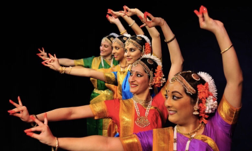
CARDIFF MORRIS MORUS CAERDYDD
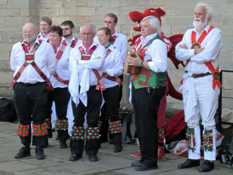
CARDIFF MORRIS are one of Wales’ earliest 1970s revival sides. Formed in1970 by a small group of experienced dancers who had migrated from Morris sides in other parts of the country, they quickly recruited local enthusiasts. These intricate dances are generally derived from the Cotswold traditions, although you may see them perform their own tradition of dance from the village of Nantgarw, just north of Cardiff. Look out for the Welsh dragon and Cardiff coat of arms on their Welsh-weave ‘baldrics’ or cross-sashes - and, of course, for Idris, their own dancing dragon.
Roedd Morus Caerdydd ymhlith y grwpiau Cymreig cynharaf i atgyfodi’r traddodiad yma yng Nghymru yn y 70au. Fe’u ffurfiwyd ym 1970 gan gnewyllyn bach o ddawnswyr profiadol o grwpiau eraill a symudodd i‘r ardal a dechrau recriwtio dawnswyr lleol. Daw mwyafri’r dawnsiau cywrain hyn o ardal y Cotswolds, er mae’r cwmni hefyd yn perfformio dawnsiau o draddoddiad Nantgarw. Chwiliwch am y ddraig goch a dyfais Caerdydd ar eu gwregysau croes (‘baldrics’) brethyn – ac wrth gwrs, am eu draig, Idris.
COBBLERS AWL COBBLERS AWL
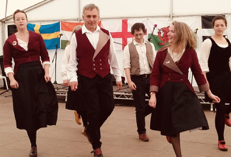
NOW firmly based in Cardiff, though drawing membership from as far afield as Bridgend, Merthyr Tydfil and the Vale of Glamorgan, Cobblers Awl have kept both Welsh and English clog-step traditions alive for over 45 years since the group first convened in Cwmbrân. Their repertoire includes routines from Lancashire, Lakeland and the North-east of England, as well as Welsh stepping, embedding traditional elements within a contemporary polyrhythmic framework. They wear wooden-soled leather clogs, handmade by the few craftsmen still creating such traditional footwear, and members practise every Monday night in The Community Space at Tesco (Gabalfa) on Western Avenue in Cardiff.
Daw Cobblers Awl o Gaerdydd, gydag aelodau o Ben-y-bont, Merthyr Tudful a Bro Morgannwg. Maen nhw wedi cadw’n fyw traddodiadau clocsio Cymnru a Lloegr am dros 45 mlynedd ers eu sefydlu yng Nghwmbrân. Maen nhw’n cynnwys dawnsiau o Swydd Gaerhirfryn, Ardal y Llynoedd a Gogledd-Ddwyrain Lloegr a dros y degawd diwethaf maen nhw wedi datblygu dawnsiau Cymreig, gan addasu elfennau traddodiadol i fframwaith aml-rhythmig cyfoes. Maen nhw’n gwisgo clocsiau lledr gyda gwadnau pren, wedi’u crefftio gan yr ychydig grefftwr sy’n dal i weithio yn y maes. Mae Cobblers Awl yn ymarfer yn y Stafell Gymunedol yn Tesco, Gebeulfa, Caerdydd ar nosweithiau Llun. Eto, gofynnwch i‘r dawnswyr am fanylion.
CWMNI GWERIN PONT-Y-PWL CWMNI GWERIN PONT-Y-PŴL
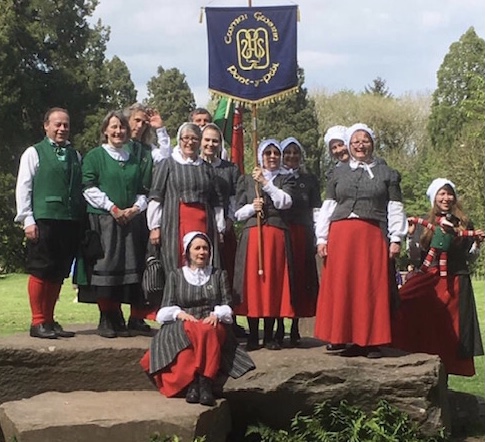
AS the name suggests, this is a dedicated team aiming to keep alive the great culture and tradition of Welsh folk music and dance. They perform at displays and festivals across Wales and the UK and throughout Europe where they have links with other traditional dance groups. Cwmni Gwerin Pont-y-Pŵl are a small and friendly group always looking for new musicians and dancers, whether experienced or inexperienced. They meet in St John’s Ambulance Hall, Hospital Road, Pontnewynydd, Pontypool NP4 8LR every Tuesday at 7.45pm and would welcome anyone interested. Please feel free to ask the dancers for details, call 01633 868707 or email cwmnigwerinpontypool@gmail.com
Fel mae’r enw yn awgrymu, dyma dîm sy’n cadw’n fyw diwylliant a thraddodiadau cerdd a dawns Cymreig. Maen nhw’n perfformio ar draws Cymru, Prydain ac Ewrop ble mae ganddyn nhw gysylltiadau gyda sawl grŵp dawns arall. Mae Cwmni Gwerin Pont-y-pŵl yn grŵp bach cyfeillgar sy’n agored iawn i groesawu aelodau newydd, boed yn ddawnswyr neu gerddorion, profiadol neu ddi-brofiad. Maen nhw’n cwrdd yn Neuadd Ambiwlans Sant Ioan, Heol yr Ysbysty, Pontnewynydd, Pont-y-pŵl NP4 8LR (what3words.com/singles.horses.ownership) bob nos Fawrth am 7:45yh. Gofynnwch i‘r dawnswyr am ragor o fanylion neu ffonio 01633 868707 neu ebostio cwmnigwerinpontypool@gmail.com
GWERINWYR GWENT GWERINWYR GWENT
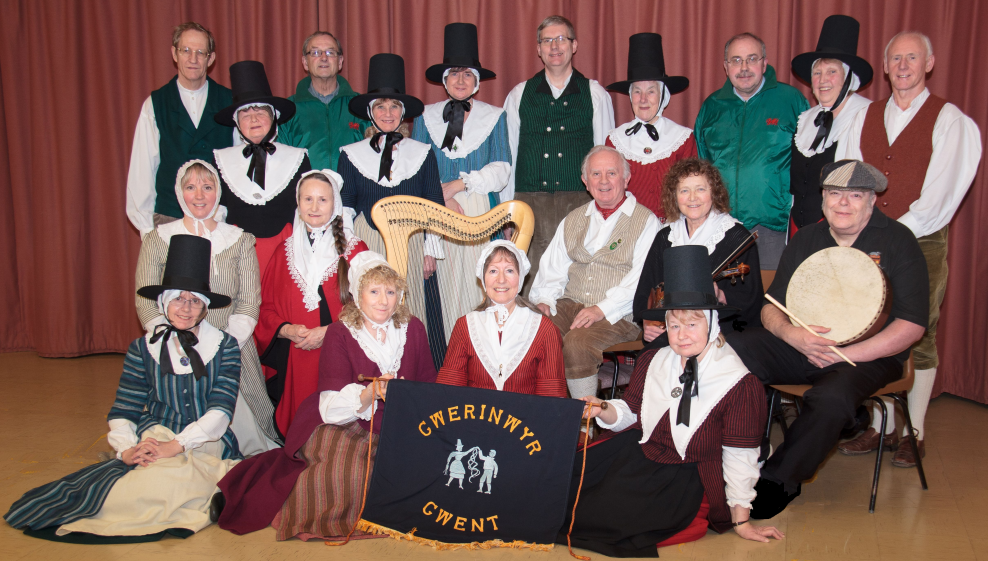
FLAMENCO FLAMENCO
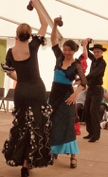
ISCA MORRIS MORUS ISCA
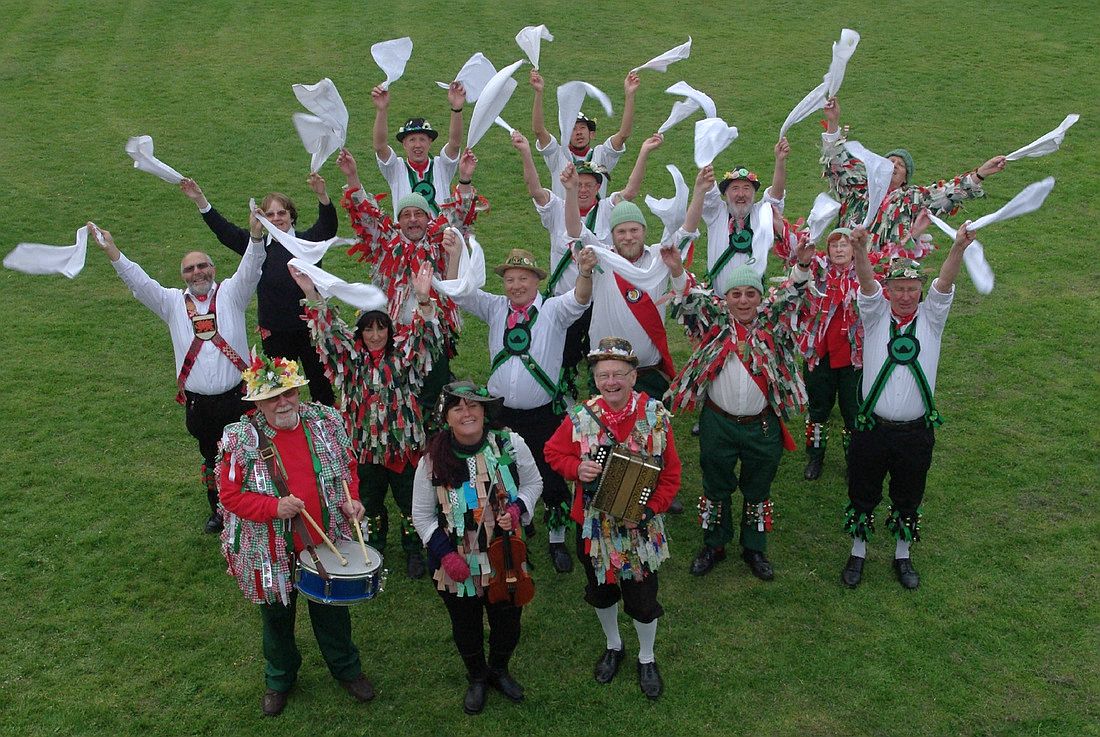
ISCA MORRIS were formed in 1976 by three experienced dancers taking their name from the Roman fortress of the Second Augustan Legion which once stood on the site of the town of Caerleon. In common with a number of other Welsh Morris sides they wear the red, white and green of Wales but include a red sash emblazoned with a Roman helmet. Their dancing season usually extends from May 1 (when they dance at dawn in the glorious Roman amphitheatre at Caerleon) to about mid-September, every Wednesday evening, at a variety of real ale pubs across Newport, Torfaen and Monmouthshire.
Sefydlwyd Morus Isca ym 1976 gan dri dawnsiwr profiadol a daw’r enw o gaer Rufeinig Ail Leng yr Ymerawdwr Augustus a safai yn nhref Caerllion. Fel timoedd Morus eraill o Gymru, maen nhw’n gwisgo lliwiau coch, gwyn a gwyrdd Cymru ond maen nhw hefyd yn cynnwys gwregys croes â llun helmed Rufeinig arno. Maen nhw fel arfer yn dechrau eu tymor dawns ar doriad gwawr ar 1af o Fai yn yr amffitheatr ysblennydd yng Ngaerllion ac yn para tan ganol mis Medi, pob nos Fercher mewn tafarndai (sy’n gwerthu cwrw go iawn) ar draws Casnewydd, Torfaen a Sir Fynwy.
SHOOSTRING SHOOSTRING

TIGER FEET TIGER FEET
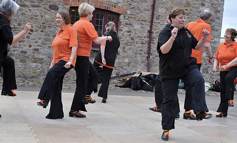
TOPAZ TRIBAL TOPAZ TRIBAL
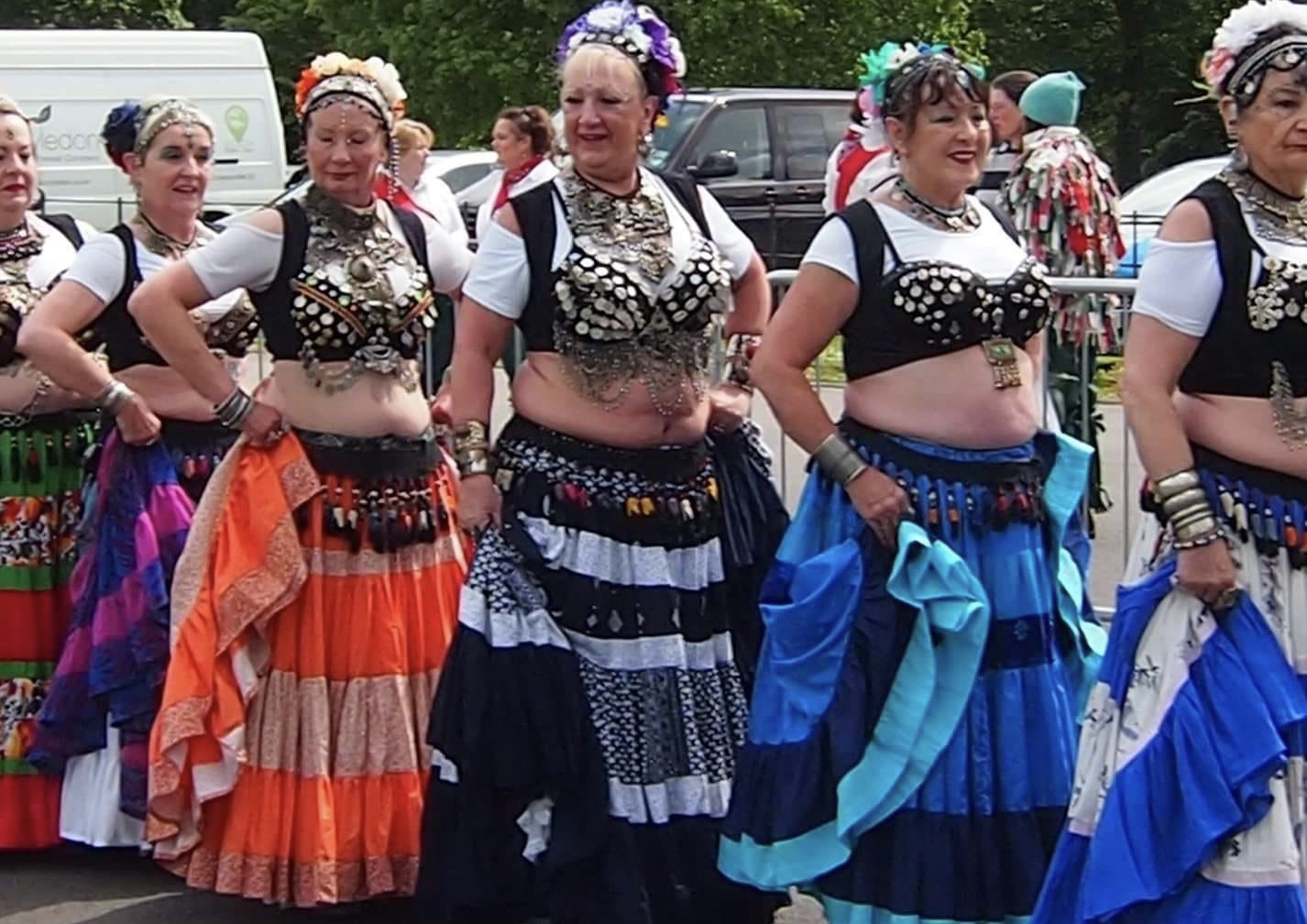
TOPAZ TRIBAL are a tribal bellydance troupe based in Abergavenny, South Wales. Wendy Hughes, director of the troupe, is certified at Level 5 and is a principal teacher in Global Caravan Tribal Bellydance. This unique style is meant to be danced in an inclusive and continuing circle using group improvisation, honouring the connection and the Sacred Feminine. Blended with contemporary dance, Topaz Tribal take inspiration from many cultures and countries from the Middle East and Spain to India, North Africa and many more. “It’s earthy and it’s grounded,” says Wendy, “and we dance from the heart.”
Mae Topaz Tribal yn grŵp Dawnsio Bola llwythi o’r Fenni, De Cymru. Mae Wendy Hughes, cyfarwyddwraig y grŵp yn Ardystiedig i lefel 5 ac yn Brif Athrawes gyda Dawnsio Bola Carafan Llwythi Byd-Eang. Dawnsir yr arddull hon mewn cylch cynhwysol parhaus gyda’r grŵp yn addasu ar y pryd ac yn anrhydeddu’r cysylltiad â’r benywaidd-cysegredig. Wedi’i asio gyda dawns cyfoes, ysbrydolir Topaz Tribal gan sawl gwlad a diwylliant – o’r Dwyrain Canol a Sbaen i Indai, Gogledd Affrica ymysg eraill. Medd Wendy “Mae’n dod o’r ddaear ac rydyn ni’n dawnsio o’r galon”.
AL RAKAS AL RAKAS

HEAPS MORRIS HEAPS MORUS

DAWNSWYR WERIN PEN Y FAI DAWNSWYR WERIN PEN Y FAI
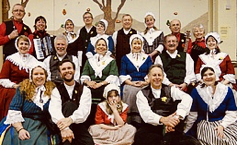
This is a team with a worldwide reputation. Each dance in their repertoire has its place snd tradition in Wales with styles varying from energetic fair dances and lively social dances to elegant court dances, all accompanied by a band of skilled folk musicians. Performers wear traditional Welsh flannel costume. On formal occasions the women wear the distinctive tall black hats.
Dyma dîm sydd wedi hen ennill eu plwyf dros y byd. Mae gan bob dawns yn eu catalog ei lle yn nhraddodiad Cymru gyda’u harddull yn amrywio o ddawnsiau ffair egnïol a dawnsiau cymdeithasol bywiog i’r rhai llys gosgeiddig, pob un i gyfeiliant cerddorion medrus. Mae’r perrfformwyr yn gwisgo brethyn Cymreig ac ar achlysuron ffurfiol mae’r menywod yn gwisgo hetiau du uchel traddodiadol.
AURORA AURORA
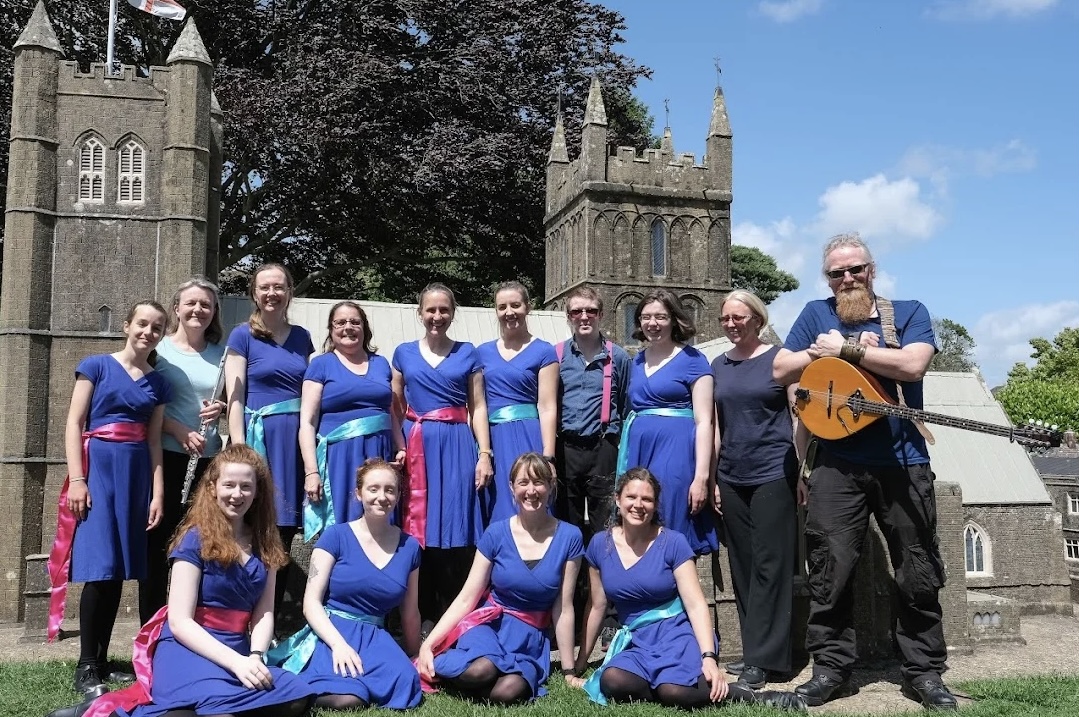
THE KNIGHTS OF KING INA MARCHOGION Y BRENIN INA

CORNUCOPIA CORNUCOPIA

DUNAVON HUNGARIAN FOLK DANCE ENSEMBLE ENSEMBLE DAWNS WERIN HWNGARI DUNAVON

CHEEKY FEET CHEEKY FEET

LOCAL MOTION DANCE COMPANY CWMNI DAWNS CYNNIG LLEOL

HOP TROP HOP TROP

O-GAM I-GAM O-GAM I-GAM

JUICE JUICE

OUTSIDE CAPERING CREW OUTSIDE CAPERNG CREW

GWERIN GWERIN
